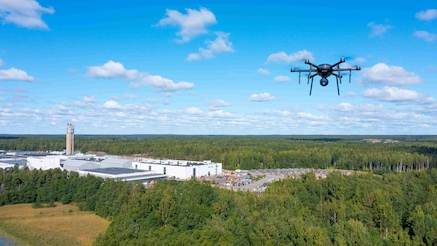Drones – it’s not a toy, it’s a tool
22 January 2025


Although drones have been around since 1935, interest in this technology has only really accelerated in the last 20 years. What started off as military technology soon found its way into the hands of hobbyists and then into the imaginations of engineers.
Hobbyists may have found other gadgets to occupy the hours, but businesses are enthusiastically exploring the possibilities of this technology, ranging from benefits to worker safety and sustainability, through to operational efficiency.
Moving from under Christmas trees to the top of pylons
One of the biggest challenges faced by the drone industry is the perception that it is a toy. Many of today’s decision makers may well have received a drone as a present from an enthusiastic aunt, and perhaps this nostalgic memory blurs the reality of today.
Instead of viewing these devices as an incredibly useful tool to evolve the way we work, we imagine someone stood in a middle of a field whizzing from one corner to the next. There will always be enthusiasts who play with these devices, but there are also a growing number of companies who are using technology to improve the workplace.
“Drone usage is becoming increasingly commonplace across business, especially for those companies who have remote operations or where there is a risk to worker safety,” said Thomas Eder, Head of Embedded Wireless Solutions at Nokia.
“If you do not have to put a human in a dangerous position, or drive hundreds of miles for an hour of inspections, why would you?”
The value of drones is multifaceted. Piloting a drone with a HD camera to the top of an electricity pylon for an inspection is considerable safer than having a human climb, not to mention the digital recording is a permanent reference, while it is also more sustainable in terms of removing unnecessary car journeys to remote locations.
This is one example, but there are countless others from the oil and gas industry (especially offshore operations), construction, remote sensing and mapping or even advanced situational awareness.
Saving lives from the skies
Nokia has recently started working with Motorola Solutions to offer a “Drone as a First Responder” service to help public services keep front line staff safe and react to incidents faster.
With the right technology, emergency services can create an automated system which helps on-the-ground responders get more information about a situation before they have arrived at the scene. The platform automates emergency call processing and drone dispatch, meaning these small machines can provide incredibly valuable information.
“When lives are at stake, every second counts,” Eder said.
“This is an example of where technology can underpin human endeavor for the benefit of all. The technology helps emergency services operate more efficiently, enabling a better service to the population and helping to keep its own people safe in the process.”
Use cases such as this have been enabled through regulatory evolution, in particular, adjusting rules for flying drones beyond-visual-line-of-sight (BVLOS). BVLOS flights have been taking place for several years to support public services, but numerous regulators are also considering industrial use cases as well.
In the UK, for example, the Civil Aviation Authority (CAA) has introduced new rules to allow drones to operate at low heights close to infrastructure or near buildings. The restrictions minimize risk to other aircraft but enable use cases such as asset inspections or site security. A significant number of markets are considering this approach, opening the door for wider adoption of drones.
“This is a slow-moving process because of the complexity involved. There are many moving parts, and safety has been at the core of every discussion.” Eder said. “But the last few months have been incredibly exciting, and this feels like a watershed moment for the drone sector.”
Safety, security and productivity
Looking at the early trials for drone use cases, the benefits look very interesting.
Led by industries such as oil and gas, mining, ports and utilities, not to mention public safety organisations such as emergency services, many larger organizations are seeing Return on Investments within 12 months. This could be through benefits such as cost and time savings through activities such as remote inspection, as well as driving additional value to deliver on activities that would not have been previously possible because of the cost and time implications.
What is clear is that while the general perception of drones is still in the hobbyist camp, it is changing for businesses. More companies are adopting the technology, and as the policy landscape is adapted further, we expect this adoption to accelerate further.
Read more
About Nokia
At Nokia, we create technology that helps the world act together.
As a B2B technology innovation leader, we are pioneering networks that sense, think and act by leveraging our work across mobile, fixed and cloud networks. In addition, we create value with intellectual property and long-term research, led by the award-winning Nokia Bell Labs.
With truly open architectures that seamlessly integrate into any ecosystem, our high-performance networks create new opportunities for monetization and scale. Service providers, enterprises and partners worldwide trust Nokia to deliver secure, reliable and sustainable networks today – and work with us to create the digital services and applications of the future.
Media inquiries
Nokia Communications, Corporate
Email: Press.Services@nokia.com
Follow us on social media
LinkedIn X Instagram Facebook YouTube
